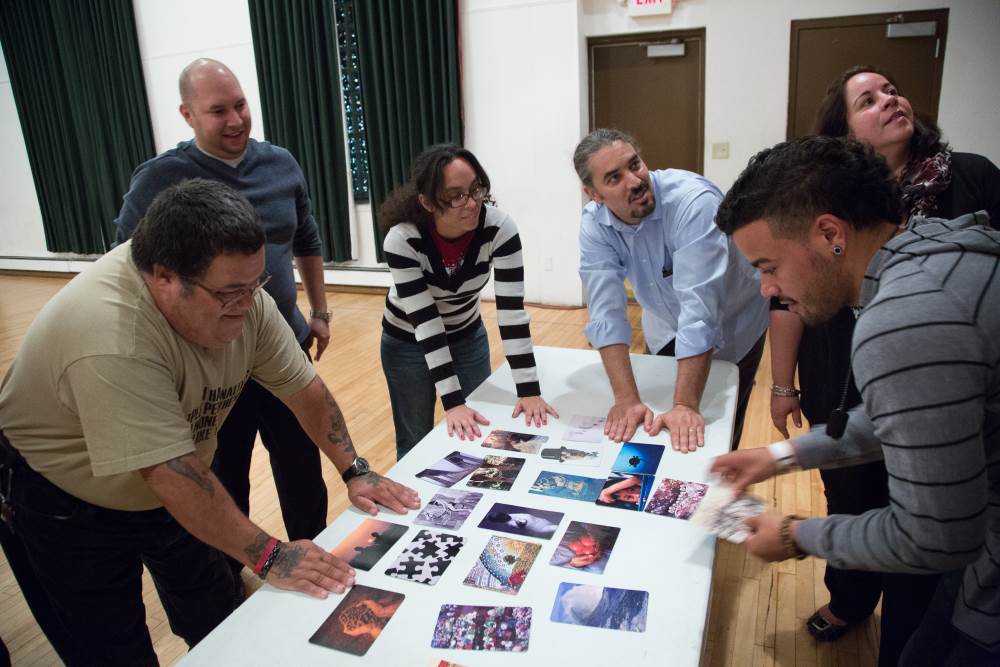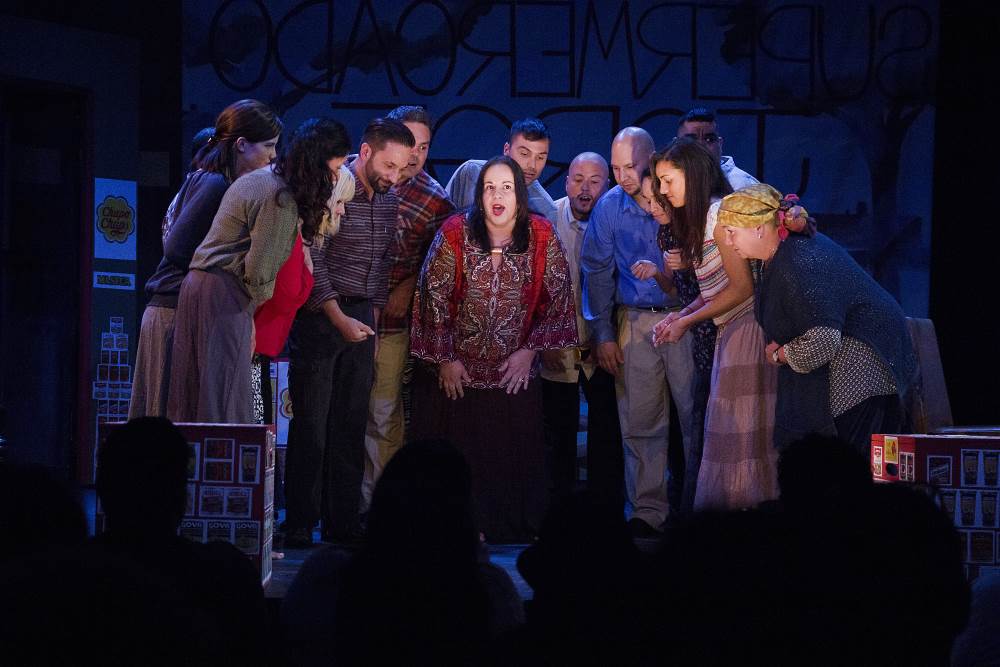In 2013, Cleveland Public Theatre artistic director Raymond Bobgan was onstage doing what he does often: a pre-show speech. In addition to the usual “please silence your cell phones,” Bobgan asked the audience: “How many of you have been to the theatre before?” Five hands rose in the air. In a house of about 150 people. This was not your typical audience.
For one, it was a mostly Latinx house. They were there to see the inaugural performance of a new Latinx performance ensemble created by CPT, called Teatro Publico de Cleveland. The show was a devised work called Cuando Cierras Your Eyes, and as soon as the curtain rose, it didn’t matter that most of that audience had never been to the theatre before. “Within one minute, the audience was just roaring with laughter,” recalled Letitia Lopez, a founding member of Teatro Publico and a Cleveland native. “It was just an awesome feeling to know that we did this. We were all backstage going, ‘Oh my gosh! They’re here, they’re laughing, they’re reacting!’ It was the best feeling.”
Lopez had never acted onstage until Bobgan approached her one day with an idea: What did she think of collaborating with CPT to create a Latinx theatre ensemble—one for which theatre experience wasn’t necessary and in which anyone could participate?
“I thought it was a great idea, I thought it was something that was very much needed,” she said. Lopez was no stranger to CPT; she is the director of the Julia de Burgos Cultural Arts Center, located a mile away from the theatre. The two institutions have collaborated on various community events, including the theatre’s annual Dias de Los Muertos celebration.
But despite the fact that Hispanic and Latinx people make up 10 percent of the population in Cleveland, with a sizable Puerto Rican community, there is no Latinx theatre in the city. “The center currently doesn’t do any theatre,” said Lopez of her main employer. “We used to years ago, and we did children’s theatre. But I thought as far as an adult Latino theatre ensemble, it would feed our souls, and I think it has.”
Teatro Publico started out with a 14-member ensemble. That first two-night run of Cuanda Cierras Your Eyes was so popular that two performances were added. Today Teatro Publico has grown to 32 members. Its shows regularly sell out, and it has served over 4,200 audience members. It now performs two shows per season at CPT, with one devised work and one Spanish-language scripted work; recent credits include Mi Muñequita (My Little Doll) and Uz, El Pueblo, both by Gabriel Calderón. Its next production is still unannounced, but it will run March 30-April 15, 2017.

For CPT’s Bobgan, the idea for Teatro Publico came from a simple realization: There weren’t enough Latinx actors in Cleveland, and he needed some.
“I was frustrated because there was a lot of plays that I wanted to produce and I couldn’t cast them,” he said, “because they require Arab or Asian or Latinos or whatever else.” It wasn’t a simple matter of looking into other markets for talent; as Bobgan conceded, “We’re not going to be able to attract people from these diverse groups to Cleveland as performers—we’re not paying massive salaries or anything. They can’t move here for that.” CPT uses both non-union actors and union members under a special performance agreement for which the minimum is around $324 a week (non-union actors are paid $50-100 a week).
In the absence of Cleveland-based Latinx performers, Bobgan decided he would help create some, bringing in local community members and giving them a crash course in theatremaking by devising work. Community-created work isn’t new for CPT; they’ve devised shows with teenagers and the local homeless population. Building the local talent pool, Bobgan figured, would have another benefit: to help CPT figure out why the local Latinx community wasn’t going to the theatre.
“We really need their stories and we want their stories onstage, and we want to be interacting with the whole community,” he said. “Also personally, as an artist, I just wanted the richness of those stories onstage.”
In creating Teatro Publico, Bobgan didn’t want the process to be led by CPT, a predominantly white institution. So he and CPT director of community ensemble Faye Hargate put together a Latinx advisory committee made up of Lopez and six other community members. It was this committee that helped select the plays, market the work, and give the theatre tips on how to attract Latinx audiences, from simple things like having a Spanish speaker at the CPT box office and bilingual signage to more grandiose ideas.
“One of the things they said is we have to have food,” said Hargate. “And we said, ‘Yes, we love food!’” It doesn’t hurt that across the street from CPT is Rincon Criollo, one of the best Puerto Rican restaurants in Cleveland. “We’re like, great, that’s another leader in the community we can involve in the project, to see if they’re open and interested in catering.” Now every Teatro Publico show has a party after with food and music, so that audiences are not getting a “cookie cutter experiences where people are dropping in or dropping out.” Instead, a Teatro Publico performance is a community event.
These connections with the Latinx populace have helped contribute to Teatro Publico’s success. They’ve also united a fractured community, said Lopez, because the ensemble is not monocultural—it includes members of Puerto Rican, Guatemalan, Peruvian, Colombian, and Uruguayan descent.
“We have such a diverse group and it’s just so awesome,” said Lopez. “Our cultures are different. We learn from each other and we have a better understanding of each other and it’s all because of Teatro.”
But Bobgan’s original goal wasn’t simply to create a few slots for Latinx actors to be relegated in CPT’s seasons; he also wanted to create a talent pool for all CPT shows. Teatro Publico has delivered on that score as well: Actors from the ensemble, including Lopez, now regularly appear in non-Teatro productions. This has also increased the local Latinx community’s appetite for the theatre’s offerings. “A lot of people who are attending our plays are now attending other plays at Cleveland Public Theatre,” said Lopez. “It’s creating a whole new world for our community.”
The project was partly underwritten by a three-year $200,000 grant from the Cleveland Foundation, and so far the donors seem satisfied with the investment. “The Cleveland Foundation and the consultants they hired said this is probably the most exciting thing that’s happening right now,” said Bobgan. So much so that they’ve given CPT an additional $5,000 a year, earmarked for Teatro Publico.
What’s more, the success of Teatro Publico has emboldened the leadership at CPT; they are now working with the local Arab-American community to create another acting ensemble, inspired by the city’s sizable population of that heritage. Considering the results of the recent election, the theatre considers its work more important than ever.
“What our drive is as an organization is to celebrate the diversity of our city,” said Hargate. “And we believe that through representation onstage and through hearing the stories of people that are different from yourself, that is what creates empathy and humanizes each other, that builds more compassion and awareness in our community, that’s the community we want to live in.”


